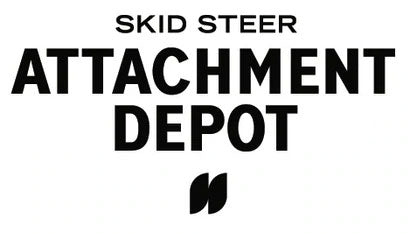What is a Skid Steer
The original concept of what is a skid steer today was brought to life in the 1950s in Minnesota to help a farmer clean turkey manure out of his barn.
Imagine if you will, a barn for raising turkeys. Frequently that barn needs to be cleaned out. No farmer in their right mind would want to clean a literal ton of turkey manure out of a barn. Especially when the standard tractor doesn't have the maneuverability to plow and dump in that confined space.

The modern-day skid steer was developed out of necessity to clean a barn full of turkeys in Minnesota.
History of the Skid Steer
This was the exact problem that turkey farmer Eddie Velo was trying to solve when he approached mechanics and brothers, Louis and Cyrill Keller, in 1957. The Kellers came up with a three-wheeled bucket loader that was turned by a castor wheel on the back. This little loader would eventually become known as the skid steer.
Able to effectively spin in place, the skid steer was a hit and quickly caught the attention of Melroe manufacturing. In 1958, Melroe Manufacturing Company bought the rights to the Kellers skid steer and hired them to refine the product.
Then, in 1960, the Melroe M-400 became the first “true” skid steer, using four wheels that turned by powering one side or the other. Melroe went on to become Bobcat, which is still the leader in skid steer manufacture and sales.
What is a Skid Steer
A skid steer is a general-purpose machine that is found on many job sights and farms across the world. For applications inside confined areas like barns or buildings, the skid steer's 0-degree turn radius is ideal.
A design feature that ensures the machine’s compactness is the lift-arm design, known as radial lift on some and vertical lift on others. The arms originate behind the cab, which helps reduce unnecessary height, compared to a front-end loader or backhoe.

A skid steer is a general-purpose machine that is found on many job sights and farms across the world.
Skid steers can also move at a decent speed. While we don’t recommend racing around a job site in any machine, skid steers can top out at 12mph so you can get your materials in and out faster than with most other loaders.
Another bonus of the skid steer is since they are such compact and often lightweight machines, trailer size can be significantly smaller than that of a tractor or earth machine. A lighter machine and trailer means skid steers can be transported using everyday trucks. For instance, a Bobcat S70 and trailer is within the towing capacity of an F-150, making it deliverable by anyone with a light-duty truck.
With the varied application demands of skid steers, manufacturers have created add ons to make them even more versatile. Beyond the original bucket loader, attachments for skid steers include:
- Trenchers - For digging pipes and lines. Very helpful for those who do irrigation work.
- Pallet forks - For moving pallets of material, versus purchasing a separate forklift.
- Snowblower - In our increasingly developed areas having a compact machine that can quickly move snow saves a lot of manpower cleaning sidewalks.
- Backhoe - Even these little machines can do some digging. While the reach won’t be as far as a traditional backhoe, in areas that can’t take that level of axle weight it’s a great compromise to using a shovel.
- Mower - For areas of heavy overgrowth, being able to push a mower instead of pulling it is a huge advantage.
These are just a few of the options for attachments that one could purchase for a skid steer. Though you will find attachments for any job you will need.
What the Skid Steer Isn’t
For all the benefits of a skid steer, there are some shortcomings. The trade-off for the skid steers 0-degree turning radius is that it chews up whatever it is turning on. For hard-packed ground or concrete that's no problem. But in mud or on turf, the results won't be pretty.
Tracked loaders or even bucket loaders with larger tires will spread the pressure more evenly and in the case of the latter option: have wheels that turn. Because of the configuration of the axles on skid steers, there is no suspension. Without suspension, traveling over uneven terrain can be rough or even dangerous. If you are expecting uneven terrain a traditional tractor may be a better choice.
When using a skid steer for removing and dumping material you may find that the rear pinned loader arms don't give much reach compared to a larger bucket loader. For putting dirt or manure in a trailer, the skid steer is more than capable; for higher walled containers the skid steer will have to get very close to the side to dump properly.
It’s easy to see why this little machine has become such an integral part of job sites and properties across the country. For specialized work on large projects to general purpose use on small properties the skid steer is the backbone of the small machine arsenal that is at your disposal. We hope that you are able to take this information and plan your next machine purchase or rental with greater confidence and success.




